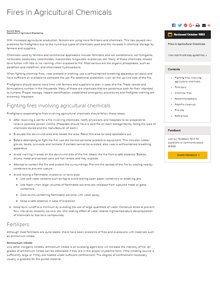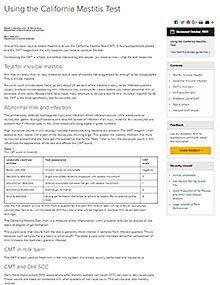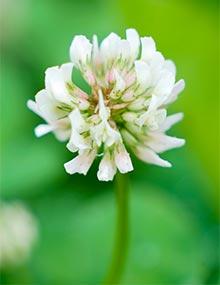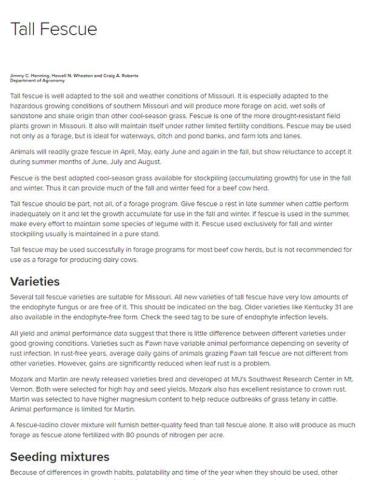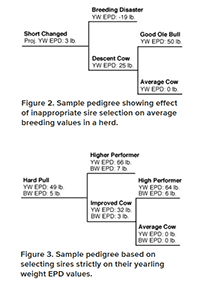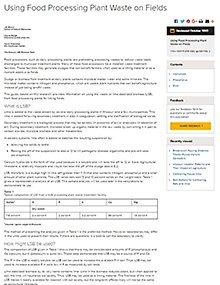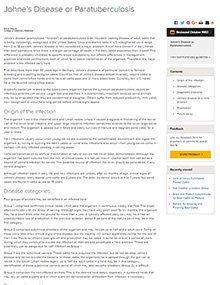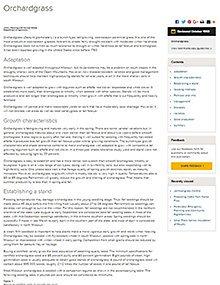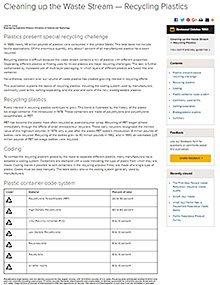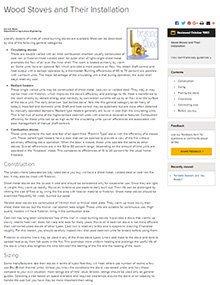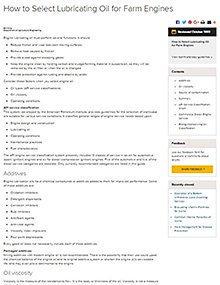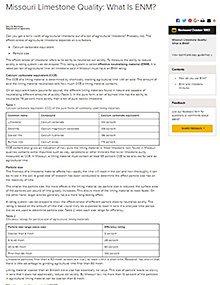
Barley
Reviewed
Winter and spring barleys are available, but testing in Missouri indicates spring barley does poorly. Plus, six-row barleys have higher yield potential than two-row barleys in Missouri. Therefore, this publication covers only the six-row winter barleys.
The Bluegrasses
Reviewed
Fires in Agricultural Chemicals
Reviewed
With increased agricultural production, farmers are using more fertilizers and chemicals. This has caused new problems for firefighters due to the numerous types of chemicals used and the increase in chemical storage by farmers and suppliers.
Estimating Peak Rates of Runoff From Small Watersheds
Reviewed
Use the following equation to estimate the peak rates of runoff to be expected from watersheds smaller than 200 acres in Missouri:
Q = QT x L x I x T x S x V x C x P x F where
Q = Peak rate of runoff, cubic feet per second.
Using the California Mastitis Test
Reviewed
One of the best ways to detect mastitis is by using the California Mastitis Test. Visit our website today to learn more.
White, Ladino and Sweet Clover
Reviewed
White and ladino cloverWhite clover is a stoloniferous plant with a shallow root system. The primary stems of white clover usually die before the second year, and the life of the plant depends upon the stolons and their haphazard roots.

Drilled Soybeans in Missouri
Reviewed
Tall Fescue
Reviewed
Tall Fescue is one of the more drought-resistant field plants grown in Missouri. Visit our website today to learn more.
Intermediate Trail Riding
Reviewed
More and more families are having fun trail riding. This activity is reasonably inexpensive, is non-competitive, and affords relaxation on nature's scenic trails.
Understanding and Using Sire Summaries: BIF Fact Sheet
Reviewed
Sire selection is one of the most important decisions cow/calf producers make. If it is effective, sire selection will account for nearly 90 percent of the genetic improvement in a herd.
Culverts and Flood Gates
Reviewed
The tables in this publication may be used to find culvert and flood gate size for bottomland drainage up to 640 acres.
A formula frequently used for calculating drainage flow rates of cultivated areas from one to one hundred square miles area in the Midwest is:
Using Food Processing Plant Waste on Fields
Reviewed
Waste, or lime stabilized biomass (LSB), from food processing plants can be used for liming fields. Learn what LSB is, how it can be used, and the soil benefits it provides in this University of Missouri Extension guide.
Renovating Grass Sods With Legumes
Reviewed
Many Missouri pastures have adequate grass stands, but they need legumes. If the soil is capable of growing them, legumes should be established in grass sods. Establishing clovers is cheaper than topdressing the grass with nitrogen.
Growth Stimulants (Implants)
Reviewed
Implants increase the weaning weight of suckling calves and increase the rate and efficiency of gain of cattle fed growing and finishing rations.
Growth stimulants implanted beneath the skin in the middle third of the backside of the ear include Compudose, Ralgro, Synovex, STEER-oid, HEIFER-oid and Finaplex-S.
Cotton Insects and Mites
Reviewed
Editor's note

Radon: An Indoor Health Hazard?
Reviewed
Indoor air can be polluted in a number of ways. Indoor pollutants include formaldehyde, carbon monoxide, respirable dust, nitrogen dioxide, radon and other gases. This guide focuses on just one of these pollutants — radon.
Brooding and Rearing Ducklings and Goslings
Reviewed
Goslings and ducklings can be brooded by broody chicken hens and most breeds of ducks and geese. Learn about brooder types, temperature, housing, feeding, watering, pasturing and fencing in this University of Missouri Extension guide.
Johne’s Disease or Paratuberculosis
Reviewed
Orchardgrass
Reviewed
Orchardgrass is a productive cool-season grass that responds to good fertility and management practices by producing up to 4 tons of high quality forage per acre. Learn how to establish and manage a stand of orchardgrass in this MU Extension guide.
Wood Stoves and Their Installation
Reviewed
How to Select Lubricating Oil for Farm Engines
Reviewed
Engine lubricating oil must perform several functions. It should:
Missouri Limestone Quality: What Is ENM?
Reviewed
Can you get a ton's worth of agricultural limestone out of a ton of agricultural limestone? Probably not. The effectiveness of agricultural limestone depends on two factors:
Alfalfa
Reviewed
Alfalfa is the most productive legume for Missouri. Visit our website today to learn more about Alfalfa.
